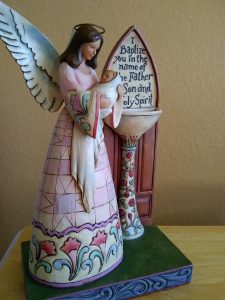
Today we attended a Baptism for the newest member of the Body of believers. We also acknowledge that our firstborn has been a Christian for several years—part of the body of believers. What a magnificent and challenging reality that is to live into. We know this because there are days this reality is difficult for us to live into (am I right?). It probably feels less than magnificent, too. That is why we continually reach for books, music, Sacraments, service projects—anything beyond our own words to illustrate and reiterate the importance and beauty of what this means for her—and for us.
Complex & beautiful
Today’s feast of Our Lady of Sorrows is an annual reminder to me that what we have asked that our child be a part of is as complex as it is beautiful. I literally remember squirming at my kitchen table as I scheduled her baptism date because it seemed like kind of a depressing day to welcome my child into the Church (as if the reality of Mary’s suffering or the Paschal Mystery are any less relevant on any other day). I distinctly remember having this impulse not to have her initiated into something that foreshadowed…heartbreak.
Given a healthy amount of distance and afterthought, I can hear my good intentions as well as the complete backwardness of this line of thinking.
This faith that she has been baptized into is not a secret weapon against suffering. Applied appropriately, it is more or less a guarantee that heartbreak will be a part of the equation for her at some point, when the world she hopes for and the one she sees, do not touch. What I think this faith is, is our best attempt to be able to look reality in the face and remain moored to a foundation bigger and more hopeful than ourselves in the midst of that suffering. In dynamic and nuanced ways, perhaps we are condoning for ourselves (and our children) an intentional experience of wrestling with the things that would otherwise break us and leave us calloused if it weren’t for the truth we hold at our core that this is not the whole story.
Think for a minute about the complexities of truths that we are holding in tension right now—maybe just skim the headlines from today.
These are the days I imagine my own mooring is at work, and probably if we’re honest, when we do the most wrestling. Suddenly, the occasion to celebrate and remember her entrance into the church becomes an opportunity for me to renew my own baptismal call as ‘priest, prophet and king.’ I know she’ll enjoy her baptismal dinner and re-visiting pictures of the day she doesn’t remember.
Saying ‘yes.’
More than that I want her to be surrounded with healthy, whole folks walking around with their hearts outside of their chests, ready to give them away to people in dire need of love, acknowledgment, eye-contact. Although we are still talking about my daughter’s baptism, I recognize that ultimately I am talking about my own as well. I also know that I am of far greater use with my heart engaged than I am with it tucked safely away—hard as that is to put into practice. So I’ll leave you with Annie Dillard’s words that encapsulate the courage necessitated by this bold ‘yes.’
Why do people in church seem like cheerful, brainless tourists on a packaged tour of the Absolute? … Does anyone have the foggiest idea what sort of power we blithely invoke? Or, as I suspect, does no one believe a word of it? The churches are children playing on the floor with their chemistry sets, mixing up a batch of TNT to kill a Sunday morning. It is madness to wear ladies’ straw hats and velvet hats to church; we should all be wearing crash helmets. Ushers should issue life preservers and signal flares; they should lash us to our pews. For the sleeping god may wake someday and take offense, or the waking god may draw us to where we can never return.”
—Annie Dillard, Teaching a Stone to Talk: Expeditions and Encounters (New York: Harper & Row, 1982), pp. 40-41.